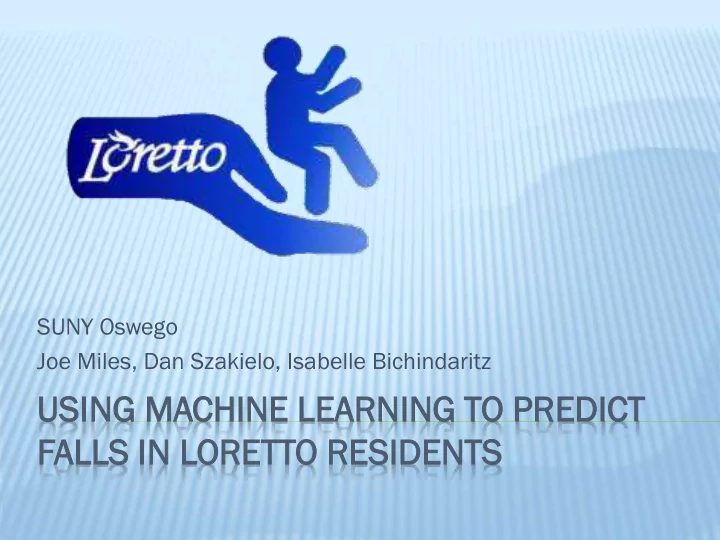

SUNY Oswego Joe Miles, Dan Szakielo, Isabelle Bichindaritz USING NG MACHINE CHINE LEAR EARNING NING TO P O PREDICT EDICT FALLS LLS IN N LOR ORET ETTO O RES ESIDEN DENTS TS
PROJECT MISSION Preventing falls and improving residents’ quality of life through the meaningful use of health record data and machine learning.
BACKGROUND Falls are the second leading cause of accidental injury deaths worldwide (WHO 2017). The CDC (2016) reports that “every second of every day in the United States, an older adult falls, making falls the number one cause of injuries and deaths from injury among older Americans.” The CDC estimates the annual Medicare cost of falls in older Americans to be $31 billion. World Health Organization. (2017). Falls Fact Sheet. Retrieved 10/12/2017 from http://www.who.int/mediacentre/factsheets/fs344/en/ Centers for Disease Control and Prevention. (2016). Falls are leading cause of injury and death in older Americans. Retrieved 10/12/2017 from https://www.cdc.gov/media/releases/2016/p0922-older-adult-falls.html
BACKGROUND, CONTINUED “Successful rehabilitation to minimize long term disability of elderly people requires that staff aim to reduce patients' dependency and to increase their autonomy during recovery from acute illness when it is associated with disability. The occurrence of some falls is an unwelcome but probably inevitable consequence of encouraging patients to regain mobility early after acute illness. None the less, there may be simple measures that could reduce the incidence of falls without the need for physical restraints, sedation, excessive supervision, or other measures that undermine a patient's dignity and independence.” Oliver, D; Britton, M; Seed, P; Martin, FC; Hopper, AH. (1997). Development and evaluation of evidence based risk assessment tool (STRATIFY) to predict which elderly inpatients will fall: case-control and cohort studies. British Medical Journal. 315: 1049-1053.
BACKGROUND, CONTINUED Many fall assessment algorithms were reviewed. We found no record of using machine learning List of common risk factors for predicting fall: 1) muscle weakness, 2) history of falls, 3) gait deficit, 4) balance deficit, 5) use of assistive device, 6) visual deficit, 7) arthritis, 8) impaired activities of daily living (including ambulation and transfer), 9) depression, 10) cognitive impairment, and 11) age > 80 years. Kenny, RA; Rubenstein, LZ; Martin, FC; Tinetti, ME. (2001). Guideline for the Prevention of Falls in Older Persons. Journal of the American Geriatrics Society. 49(5): 664-672.
DATA ANALYZED 22 comma-separated value (csv) tables with 11843 resident records from January 2005 to present The four tables used: ICD 1. General Admission Observation 2. Fall Assessment 3. Norton 4.
VARIABLES ANALYZED ICD Gen Ad Admission ission Fall Assess essmen ment Norton on 290 290 Confusion Previous fall Physical condition 294 94 Toilet Performance Cognitive Mobility status/behavior 331 Verbalization of Pain Age (85 or older) Incontinence F03 03 Complains of chest Health condition Gender pain G30 30 Age On Admission
ICD ANALYZED
RESULTS J48 48-18 18V RT RT-18 18V J48 48-25 25V J48 48-8V RT RT-8V RT RT-Si Simple ple True Pos 4321 6502 6349 7107 6790 6519 False se Pos 3197 2701 2854 2647 2194 1666 True Neg 7811 8307 8154 8361 8814 9342 False se Neg 6013 3832 3985 3227 3544 3815 Ac Accu curacy acy 56.8% 69.4% 68.0% 72.5% 73.1% 74.3% Specif ifici icity ty 71.0% 75.5% 74.1% 76.0% 80.1% 84.9% PPV PPV 57.5% 70.7% 69.0% 72.9% 75.6% 79.6%
RESULTS
MORE TO CONSIDER Instinct and intuition = good Audible alarms = bad
THE FUTURE FOR THIS PROJECT Using data analytics to identify residents at the highest risk of falling could become an important aspect of preventing falls in the future. Results need to be re-tested and validated Future prospective analysis Future research Implementation
Recommend
More recommend